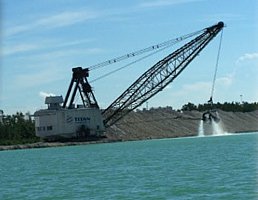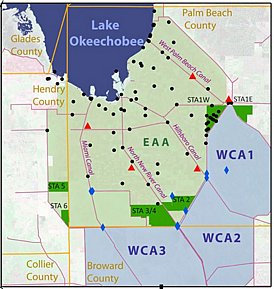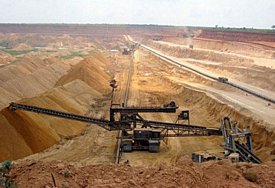| |

Discussion of the rock mining issue - some press clips:
 Mining can degrade water quality.
Tampa Bay Times, Apr.4/13
Mining can degrade water quality.
Tampa Bay Times, Apr.4/13
 Pasco County Commission rejects limerock plans in Shady Hills.
Tampa Bay Times, Apr.24/12
Pasco County Commission rejects limerock plans in Shady Hills.
Tampa Bay Times, Apr.24/12
 Rock mines, wind turbines don't belong in Everglades.
St. Petersburg Times, Sep.15/11
Rock mines, wind turbines don't belong in Everglades.
St. Petersburg Times, Sep.15/11
 Residents concerned about sand mine in back yard.
NewsChief.com, Aug.27/11
Residents concerned about sand mine in back yard.
NewsChief.com, Aug.27/11
 Lee likely to deny mining request.
News-Press.com, Aug.18/11
Lee likely to deny mining request.
News-Press.com, Aug.18/11
 Phosphate Industry Is Challenged on Pollution.
The Ledger,
Aug.17/11
Phosphate Industry Is Challenged on Pollution.
The Ledger,
Aug.17/11
 Mining in the Everglades – NOT permitted: 1000 FRIENDS OF FLORIDA, INC. versus PALM BEACH COUNTY,
Leagle.com, Aug.3/11
Mining in the Everglades – NOT permitted: 1000 FRIENDS OF FLORIDA, INC. versus PALM BEACH COUNTY,
Leagle.com, Aug.3/11
 Firms, environmentalists polarized on Everglades mining as moratorium expires,
Palm Beach Post, Jul.9/11
Firms, environmentalists polarized on Everglades mining as moratorium expires,
Palm Beach Post, Jul.9/11
 Excavation, rock crushing expected to give way to Everglades restoration,
Sun Sentinel, May.9/11
Excavation, rock crushing expected to give way to Everglades restoration,
Sun Sentinel, May.9/11
 County Commissioners Discuss Mining Deregulation Bill,
The Island Sand Paper, Apr.28/11
County Commissioners Discuss Mining Deregulation Bill,
The Island Sand Paper, Apr.28/11
 SIERRA CLUB, INC. versus U.S. ARMY CORPS OF ENGINEERS,
US Court of Appeals, 11th Circuit, Apr.8/11
SIERRA CLUB, INC. versus U.S. ARMY CORPS OF ENGINEERS,
US Court of Appeals, 11th Circuit, Apr.8/11
 Reservoir made from rock pits - Loxahatchee River test
Reservoir made from rock pits - Loxahatchee River test
Sun Sentinel, Feb.21/11
 Mosaic files permit for more mining
Mosaic files permit for more mining
Bradenton.com, Feb.4/11
 Federal agency may launch in-depth review of Lee-Collier rock mining
Federal agency may launch in-depth review of Lee-Collier rock mining
Naples News, Nov.28/10
 Deal could let Mosaic reopen mine.
Deal could let Mosaic reopen mine.
Star Tribune, October 28/10
 Rock mining moratorium gets final OK.
TCPalm, Aug.26/10
Rock mining moratorium gets final OK.
TCPalm, Aug.26/10
 Rock mining temporarily banned in Everglades.
Rock mining temporarily banned in Everglades.
The Florida Independent, Aug.8/10
 Judge Bans Mosaic mine expansion: Layoffs to be evaluated. Judge Bans Mosaic mine expansion: Layoffs to be evaluated.
The Ledger.com, July 31/10
 Land mining will destroy our habitat.
Sun-Sentinel, July 23/10 Land mining will destroy our habitat.
Sun-Sentinel, July 23/10
 Palm Beach County approves one-year moratorium on rock mining.
Palm Beach Post,
Palm Beach County approves one-year moratorium on rock mining.
Palm Beach Post,
July 22/10
 Palm Beach County temporarily bans new rock mines on Everglades land.
Palm Beach County temporarily bans new rock mines on Everglades land.
Sun-Sentinel, July 22/10
 County needs comprehensive plan for rock mining.
County needs comprehensive plan for rock mining.
Palm Beach Post Jul 20/10
 NRDC helps environment by fighting Florida Everglades mining project.
NRDC blog, July 11/10
NRDC helps environment by fighting Florida Everglades mining project.
NRDC blog, July 11/10
 County Commission approves additional rock mining.
County Commission approves additional rock mining.
Sun Sentinel, Apr 22/10
 Appeals court agrees: Corps messed up on Everglades mining permits. Jan 23/10
Appeals court agrees: Corps messed up on Everglades mining permits. Jan 23/10
PavingParadise.com-Blog,
|
| |
| |
ISSUE: Rock Mining |
Science Facts |
|
| |

|
Rock Mining Impacts - underground and surface water mixing
Video by Clean Water Fund |
Read the most recent scientific article in full - PDF |
| Dr. Naja of the Everglades Foundation discusses the impacts of rock mine expansions in the vicinity of the Everglades.She recently provided an expert testimony for the Palm Beach County commissioners. Underground waters have 5-times higher levels of sulfate and chlorides. There is a profound negative impact of particularly these two compounds on the environment when they are "surfaced" by the expanded mining activities. The impact of contaminated surface waters is of a long-term nature - the lifetime of the new mines is estimated at more than 75 years. |
|

Mining in the Everglades Agricultural Area - next to the Everglades
(red triangles).
There is a danger of the surface and underground aquifer waters mixing and contamination of both.
|
Hydrochemical Impacts of Limestone Rock Mining
G. Melodie Naja, Rosanna Rivero, Stephen E. Davis, Thomas Van Lent
(Water, Air and Soil Pollution Journal - online in August 2010) |
| Abstract
CLICK here for full PDF text
Hydrochemical impacts of shallow rock industrial-scale mining activities close to sensitive constructed and natural wetlands were investigated. The shallow surficial groundwater and surface water in the Everglades Agricultural Area (EAA) were characterized. The chemical composition of sulfate and chloride in groundwater increased with depth. The average concentration of chloride averaged 182 mg/L at 6 m deep and increased gradually to 1,010 mg/L at 15 m deep, 1,550 mg/L at 30 m deep to reach 7,800 mg/L at 60 m deep. Comparatively, the surface water chemical composition in the surrounding areas showed much lower cationic and anionic charge. The specific conductivity and total dissolved solids of surface water in canals (close to the mining operations) are <900 μS/cm and <600 mg/L, respectively, which should be compared to groundwater quality in wells from the EAA area (>2,000 μS/cm and >1,000 mg/L, respectively). A steady-state groundwater fluid flow and transient solute transport modeling exercise was conducted to estimate surface/groundwater interactions. The modeled solute in surface water was transported downgradient through groundwaters, migrated approximately 30 m from the source area (after 5 years of operation), and needed more than 116 years to dissipate. An upward transport was also identified whereby chloride and sulfate, naturally present in deeper groundwaters, migrated approximately 200 m (after 1 year of mining) into the pristine shallower aquifer and reached the surface water with a concentration equaling 80% of that in the rock mining pit.
|
|

Mining of Phosphate - a highly regarded and finite commodity closer to depletion - worldwide.
World agriculture and its productivities are completely dependent on the availability of phosphate fertilizers.
|
County Commissioners Discuss Mining Deregulation Bill
(The Island Sand Paper – by Keri Hendry - online in April 2011) |
A new Senate bill that has the potential to derail local efforts to harness mining was the topic of discussion at the county commission meeting on Tuesday, as was another, seemingly contradictory bill that makes the county responsible for growth management.
Senate Bill
SB-1122 rewrites all growth management statutes in Florida, making individual counties responsible for what was previously the state's job, but at the same time it reduces the Florida Department of Environmental Protection and slashes the Florida Department of Community Affairs – two agencies that the county would rely on if they had to take over growth management.
"This amendment was rushed through,” said Commission Chairman Frank Mann. "No one has had a chance to look at it.”
House Bill
HB-991 has even scarier implications. By taking away the county's rights to control mines, it threatens the control the county has on protecting local resources. For instance, a mine that is scheduled to be built south of Corkscrew Road in Collier County could threaten the Corkscrew Regional Ecosystem as well as the Audubon Corkscrew Swamp – both vital to the area's supply of drinkable water.
"This has a lot to do with surface water management and aquifers,” Mann said.
"So they want us to put on our big boy pants and control growth management, but want to preempt our ability (to cite and control mines)?” quipped Commissioner John Manning.
Commissioner Judah pointed out that there is enough rock aggregate in the Alico corridor for 30 years and that Lee County officials aren't against mining, they just want to have a say where it occurs.
"The state is trying to preempt (home rule) and allow for the raping and scraping of land,” he said, "Wherever and whenever.”
The commissioners agreed to review a letter drafted by Judah's office in regards to SB 1122 and plan to reach out to local legislative delegates about HB 991.
|
|
Check the LEGAL page of the
evergladesHUB.com |
 |
| |
![]()
![]() Mining can degrade water quality.
Tampa Bay Times, Apr.4/13
Mining can degrade water quality.
Tampa Bay Times, Apr.4/13
![]() Pasco County Commission rejects limerock plans in Shady Hills.
Tampa Bay Times, Apr.24/12
Pasco County Commission rejects limerock plans in Shady Hills.
Tampa Bay Times, Apr.24/12
![]() Rock mines, wind turbines don't belong in Everglades.
St. Petersburg Times, Sep.15/11
Rock mines, wind turbines don't belong in Everglades.
St. Petersburg Times, Sep.15/11
![]() Residents concerned about sand mine in back yard.
NewsChief.com, Aug.27/11
Residents concerned about sand mine in back yard.
NewsChief.com, Aug.27/11
![]() Lee likely to deny mining request.
News-Press.com, Aug.18/11
Lee likely to deny mining request.
News-Press.com, Aug.18/11
![]() Phosphate Industry Is Challenged on Pollution.
The Ledger,
Aug.17/11
Phosphate Industry Is Challenged on Pollution.
The Ledger,
Aug.17/11
![]() Mining in the Everglades – NOT permitted: 1000 FRIENDS OF FLORIDA, INC. versus PALM BEACH COUNTY,
Leagle.com, Aug.3/11
Mining in the Everglades – NOT permitted: 1000 FRIENDS OF FLORIDA, INC. versus PALM BEACH COUNTY,
Leagle.com, Aug.3/11
![]() Firms, environmentalists polarized on Everglades mining as moratorium expires,
Palm Beach Post, Jul.9/11
Firms, environmentalists polarized on Everglades mining as moratorium expires,
Palm Beach Post, Jul.9/11
![]() Excavation, rock crushing expected to give way to Everglades restoration,
Sun Sentinel, May.9/11
Excavation, rock crushing expected to give way to Everglades restoration,
Sun Sentinel, May.9/11
![]() County Commissioners Discuss Mining Deregulation Bill,
The Island Sand Paper, Apr.28/11
County Commissioners Discuss Mining Deregulation Bill,
The Island Sand Paper, Apr.28/11
![]() SIERRA CLUB, INC. versus U.S. ARMY CORPS OF ENGINEERS,
US Court of Appeals, 11th Circuit, Apr.8/11
SIERRA CLUB, INC. versus U.S. ARMY CORPS OF ENGINEERS,
US Court of Appeals, 11th Circuit, Apr.8/11
![]() Reservoir made from rock pits - Loxahatchee River test
Reservoir made from rock pits - Loxahatchee River test![]() Mosaic files permit for more mining
Mosaic files permit for more mining![]() Federal agency may launch in-depth review of Lee-Collier rock mining
Federal agency may launch in-depth review of Lee-Collier rock mining![]() Deal could let Mosaic reopen mine.
Deal could let Mosaic reopen mine.![]() Rock mining moratorium gets final OK.
TCPalm, Aug.26/10
Rock mining moratorium gets final OK.
TCPalm, Aug.26/10
![]() Rock mining temporarily banned in Everglades.
Rock mining temporarily banned in Everglades.![]() Judge Bans Mosaic mine expansion: Layoffs to be evaluated.
Judge Bans Mosaic mine expansion: Layoffs to be evaluated.![]() Land mining will destroy our habitat.
Sun-Sentinel, July 23/10
Land mining will destroy our habitat.
Sun-Sentinel, July 23/10
![]() Palm Beach County approves one-year moratorium on rock mining.
Palm Beach Post,
Palm Beach County approves one-year moratorium on rock mining.
Palm Beach Post, ![]() Palm Beach County temporarily bans new rock mines on Everglades land.
Palm Beach County temporarily bans new rock mines on Everglades land.
![]() County needs comprehensive plan for rock mining.
County needs comprehensive plan for rock mining.![]() NRDC helps environment by fighting Florida Everglades mining project.
NRDC blog, July 11/10
NRDC helps environment by fighting Florida Everglades mining project.
NRDC blog, July 11/10
![]() County Commission approves additional rock mining.
County Commission approves additional rock mining.
![]() Appeals court agrees: Corps messed up on Everglades mining permits. Jan 23/10
Appeals court agrees: Corps messed up on Everglades mining permits. Jan 23/10






